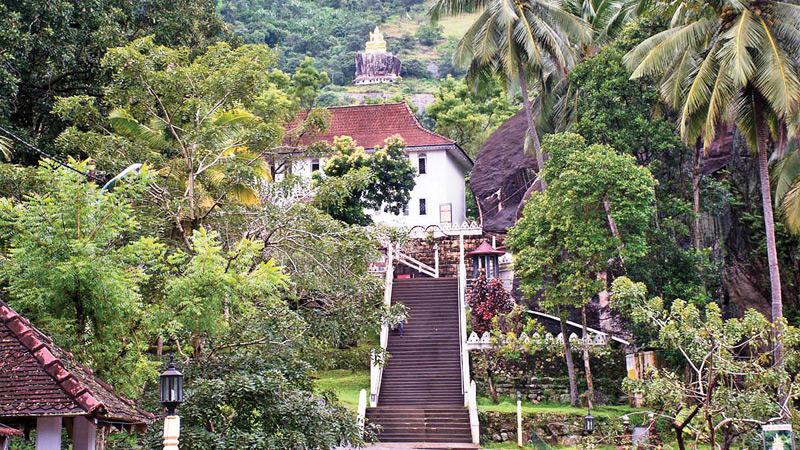
I still remember the first trip we made to Matale Aluvihare when we were students. That was a long time ago, but recently, I had the opportunity of visiting this famous rock temple again. Indeed, it was a trip down memory lane. The Aluvihare Rock Temple, also known as ‘Aluvihare’ is one of the hallowed Buddhist temples located in Aluvihare in the Matale district of the Central Province. The rock temple, surrounded by hills, covered in lush green vegetation is located a few kilometres from the Matale town on the Dambulla – Matale road.
According to legend, this historical place was originally known as ‘Alu Lena’ or ‘Aloka Lena’ (luminous cave), which later became ‘Aluvihare’ as the Pali term ‘Aloka’ was referred to as ‘Alu’ (light) in the old Sinhala language. Since the place was an abode of Buddhist monks, it was called ‘Viharaya’, and it is the combination of these two words that made up the term ‘Aluvihare’, which has now become a tourist attraction in the country.
The rock temple has a long history dating back to 3rd century BC to the reign of King Devanampiyathissa during whose time Buddhism was introduced to the country. It is believed, the King built the dagoba, planted the Bo sapling and founded this temple complex during his reign. Aluvihare is of great historic significance as it is here that the ‘thripitaka’ (Pali canon or the Buddhist doctrine) was first documented on ola leaves, or ‘Puskola poth’. There was a specific reason for the transcription of the canon in this manner.
During the reign of King Walagamba in 1st century BC, the country underwent a terrible famine for almost 12 years, while there was also a South Indian invasion at the same time.
The Buddhist monks of that era thought these conditions would have a pernicious effect on the existence of the Buddhist order in the country. Memorizing and repeating of the doctrine was a difficult task under these circumstances – so, they believed documentation would be the best option.
The famine forced the monks to leave to Malaya Rata, said to be the hilly area of the country, since they did not receive alms due to the famine. They had to take up abode on the banks of the Mahaweli River under harsh conditions, living off the land for their survival until the famine came to an end. Meanwhile, King Walagamba who was overthrown during the South Indian invasion was able to ascend the throne again by defeating the South Indian invaders.
With the end of this difficult period, the monks who left for India and the hilly areas returned to Anuradhapura and decided to transcribe the Thripitaka (canon), the philosophical doctrines of Buddhism for preservation and the use of future generations. This significant event took place at the Aluvihara rock temple premises as it was the most suitable and secure place. The transcription was thus carried out for fear that the doctrine would be lost during the period of upheaval caused by repeated South Indian invasions. Around 500 scholarly monks are said to have congregated at the temple to perform the difficult task.
The doctrines or the Buddhist scriptures – Vinaya Pitaka, Abhidhamma Pitaka and Sutra Pitaka were all written on ola (palm) leaves in the Pali language with the use of a stylus as there were no books, pens or printing equipment available those days.
Unfortunately, many of the Buddhist writings at Aluvihare were destroyed by foreign invaders such as the Dutch. When the British army invaded the area in 1848, much damage was caused to the temple and a large number of manuscripts burnt down. However, later the British government took action to restore the temple during their colonial rule. At present, the remaining manuscripts could be seen in the temple museum, which also consists of some archaeological findings.
It is said, Kings Nissanka Malla and Sri Wijaya Rajasinghe had given top priority to preserve and renovate this temple. King Walagamba ordered all Viharayas in the island to organize a ‘Pahan Puja’ (lighting of oil lamps) to mark the event of the documentation of the canon, which took more than three years to complete.
This event later became an annual event where a procession started. However, in the course of time, this custom ceased, but in 1973 the ‘Sangayana procession’ recommenced. Since then, the procession is conducted annually on the Full Moon Poya day of June at Aluvihare.
It is recorded that a scholar monk called Buddhagosha from India visited Aluvihare in the 5th century AC. He is said to have resided at this temple and written the doctrine of the Buddha in Pali with much dedication. However, not much is known about this priest. There is a separate cave by the name of this monk in the temple premises.
At present, some modern structures have been built enhancing the beauty of this historical place. At the entrance, a Makara Thorana with figures of Doratupala (gatekeeper), paintings of lions and flags with the sun and the moon and an Athpawura (wall with elephants) have been constructed. Almost daily, visitors throng this place.
A special event that took place at Aluvihara temple some time back under the patronage of Sri Lankan President Maithripala Sirisena, was the declaration of the Tripitaka as a National Heritage.
